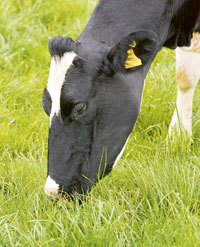Dry cow management prevents knock on problems

Turning far-off dry cows out to grass is usual practice for many dairy producers, but on closer investigation, it’s one that Mark Thomasson – who farms 1100 pedigree Holsteins at Nantwich – found led to an escalating number of milk fever incidences among the fresh calvers.
“We had been achieving our target of 3% milk fever cases within the herd. However, our weekly recording system – developed by our nutritionist, Bryn Davies of Advanced Nutrition and Rob George, a vet with the Nantwich Vet Group – indicated that it had soared past the 8% mark,” explains Mr Thomasson who farms with his father John, and brother Rob. “We believe dry cow nutrition is critical and getting it right pays dividends in the next lactation as far as yield, health and fertility are concerned. So we split the eight-week dry period in two: the far-offs and the near-to calving cows. Last year we happened to be feeding the far-off dry cows in two separate systems,” he adds.
While both groups of cows were at grazed grass, one was supplemented with an average 12kg grass and maize silage plus whole-crop wheat and 3kg straw a head a day from a trailer, while the other had no supplements. After five weeks, both groups of far-offs were introduced to the near-to calving supplement comprising the same forage diet with a concentrate premix added and they were housed for the remaining three weeks.
“After two weeks of observing the growing number of milk fever cases on the weekly recording system, we noticed the trend was isolated to the unsupplemented group,” explains Mr Thomasson.
This is because while it’s easy to assume grazed grass provides ample nutrients for dry cows eight to three weeks off calving, these swards can carry high levels of potassium which interferes with magnesium absorption in the rumen and ultimately pushes the cow towards low-calcium availability at calving, explains Mr Davies.
“To rectify the milk fever problem, the Thomassons introduced the same supplement to reduce the level of fresh grass being grazed and the subsequent level of potassium being consumed by all the far-off dry cows. Within weeks the incidence level was back to the target of less than 3%.”
The Thomasson’s weekly recording system collates data from four other computerised systems already up and running at Aston Lower Hall – for calving numbers and metabolic disorders, mastitis, fertility and milk quality. It also sets herd targets for major health issues, from milk fever and ketosis to retained cleansings, metritis and displaced left abomasums.
“The weekly system helps to identify problems, for example we didn’t think we had many retained cleansings until we started the recording system properly, which led us to set a target that we now achieve. The system has brought a better focus to the herd and introduced us to taking a more preventative approach to health,” says Mr Thomasson.
Preventative methods for controlling all metabolic problems are vital to reducing running costs on high performance herds, adds vet Rob George. “The incidence of milk fever ranges from 0-10%, but will exceed 25% of calvings, while subclinical milk fever incidences are estimated to be between 25% and 50% within the national herd. Also, sub-clinical milk fever in high-yielding cows can last for up to 40 days after a normal calving.
“Working closely as a team at Aston Lower Hall with the Thomassons, their nutritionist and myself, has enabled us to correct the clinical and subclinical milk-fever issues using simple measures. These measures have also prevented the knock-on effects of milk fever creeping in such as metritis, ketosis and displaced abomasums.”
